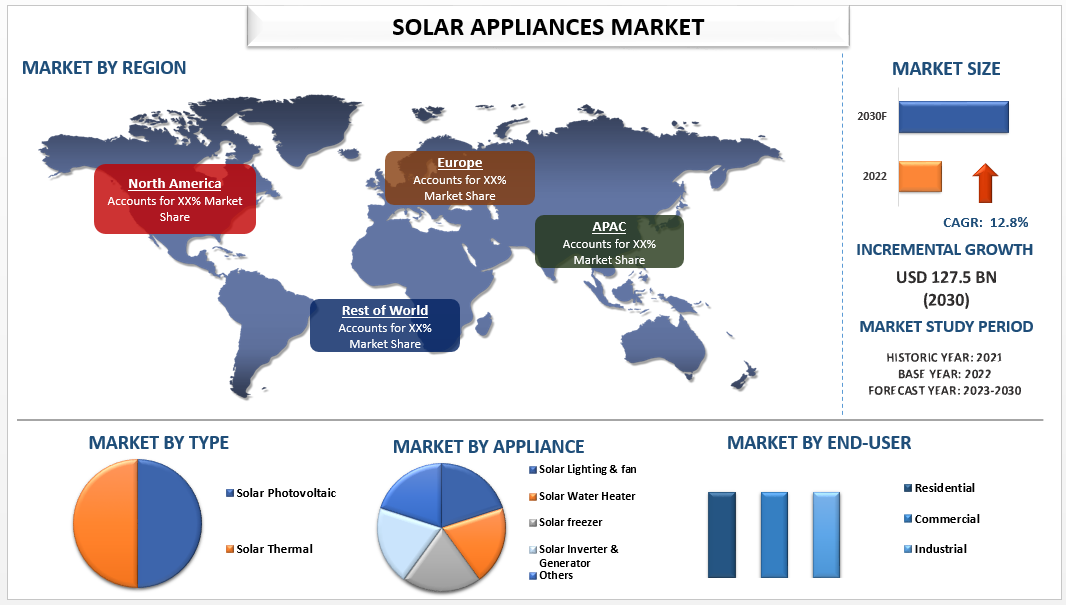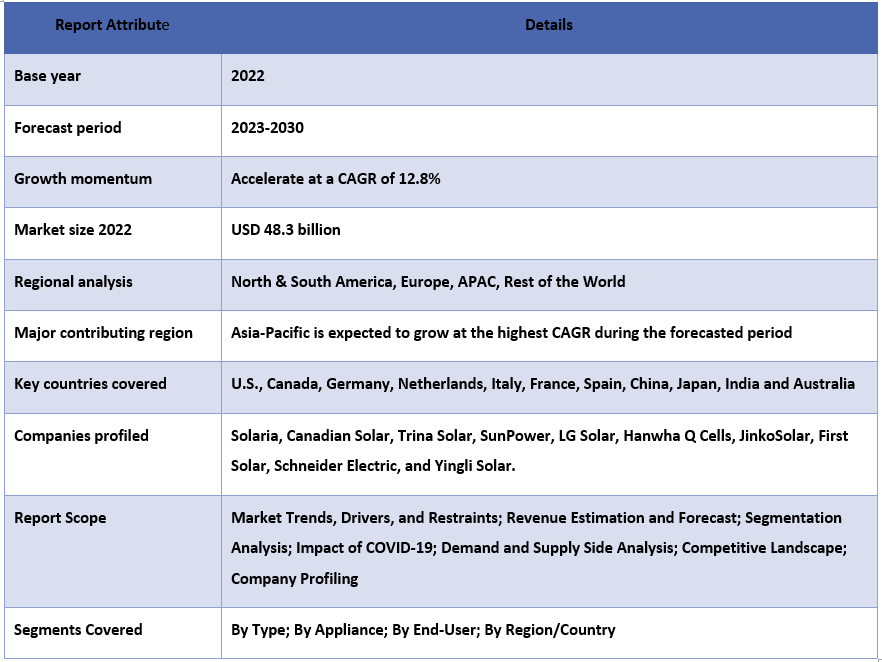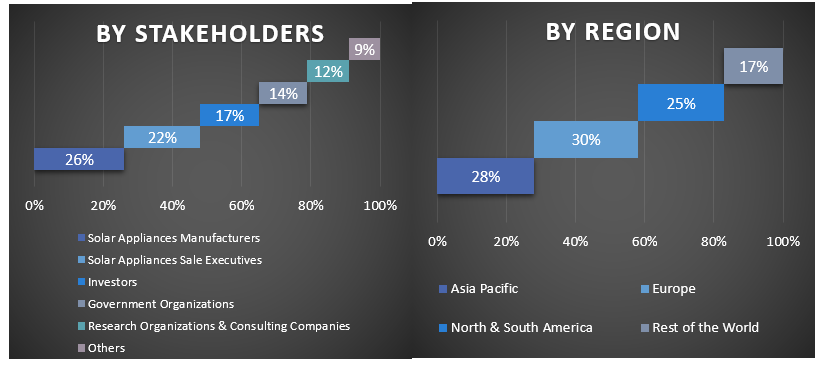Solar Appliances Market: Current Analysis and Forecast (2023-2030)
$3999 – $6999
Emphasis on Types (Solar Photovoltaic and Solar Thermal); Appliance (Solar Lighting & fan, Solar Water Heater, Solar freezer, Solar Inverter & Generator, and Others); End-User (Residential, Commercial, and Industrial); Region/Country.
| Pages: | 161 |
|---|---|
| Table: | 74 |
| Figure: | 105 |
| Report ID: | UMEP212482 |
| Geography: |

Report Description

Solar Energy generation increased by 22%, an amount of 179 TWh in 2021 to exceed 1,000 TWh overall power. Solar PV is one of the world’s lowest-cost options for electricity generation. Solar PV accounts for nearly 3.6% of electricity generation globally and it is the third largest renewable electricity technology behind wind and hydropower. The rise in solar technology has led to innovative products that are integrated with solar panels. Products such as solar lights have even been incorporated into various government projects around the world.
The Solar Appliances Market is expected to grow at a strong CAGR of 12.8% during the forecast period owing to the rising sale of solar panels and increasing investment in the renewable sector. Moreover, the need to meet net zero emission goals across the globe in various countries and rising consumer awareness towards environmentally friendly energy is acting as a catalyst in the growth of the Solar Appliances Market globally during the projected period. Solar power generation needs to grow by a CAGR of 25% for the period of 2022-30 in order to meet the targets set by the Net Zero Emissions 2050 policy.
Countries worldwide are heavily investing in renewable energy to meet their renewable energy targets. The solar energy market is one of the prominent sources of energy that has seen a massive boom in the last decade. For instance, In the USA, one of the leading nations for solar power, solar has experienced an average annual growth rate of 33% in the last decade alone. Thanks to strong federal policies like the Solar Investment Tax Credit, rapidly declining costs, and increasing demand across the private and public sectors for clean electricity, more than 140 gigawatts of solar capacity are installed nationwide, enough to power 25 million homes.
Some of the major players operating in the market include Solaria, Canadian Solar, Trina Solar, SunPower, LG Solar, Hanwha Q Cells, JinkoSolar, First Solar, Schneider Electric, and Yingli Solar. Several M&As along with partnerships have been undertaken by these players to facilitate customers with hi-tech and innovative products/technologies.
Insights Presented in the Report
“Amongst Type, the Solar Photovoltaic category held the dominant share of the market in 2022”
Based on Type, the Solar Appliances market is bifurcated into Solar Photovoltaic and Solar Thermal segments. The Solar Photovoltaic segment acquired a majority share in the Solar Appliances market and is expected to register a substantial growth rate during the forecast period. A Solar Photovoltaic appliance is an appliance that is connected to electricity-generating solar panels mounted on a building, structure, or on the appliance itself. Most Solar Photovoltaic appliances are usually residential and commercial. Solar Photovoltaic systems are growing on account of the massive integration of these solar appliances in government projects which is acting as a major driver during the forecast period.
“Amongst Appliance, the solar inverter & generator category held the dominant share of the market in 2022”
Based on Appliance, the Solar Appliances market is divided into Solar Lighting & fan, Solar water heater, solar freezer, solar inverter & generator and others segments. The solar inverter & generator segment acquired a substantial share as backup energy is one of the main reasons people shift towards solar energy. The solar lighting and fan segment would showcase high growth on account of their rising adoption in government projects as the majority of countries are shifting towards renewable energy. The rising green laws are acting as a catalyst in the growth of Solar Lighting & fans globally during the forecast period.
“Amongst Applications, the Commercial category held the dominant share of the market in 2022”
Based on Application, the Solar Appliances market is divided into Residential, Commercial, and Industrial segments. The Commercial segment acquired a majority share in the Solar Appliances market and is expected to showcase a substantial growth rate during the forecast period. Commercial PV remains the most competitive source of PV generation globally. Moreover, Solar PV is the main choice for the private sector if they want to invest in renewable energy. Companies investing in distributed (including Solar Photovoltaic) solar PV installations on their commercial buildings and premises are responsible for around 30% of the total installed PV capacity, moreover, Companies are entering into corporate power purchase agreements with solar PV plant operators. Solar appliances bought by Government contracts which make up a substantial source of investment in the solar appliance market are also included in the commercial segment.
Solar Appliances Market Report Coverage

“APAC held a dominant share of the market in 2022”
APAC registered the highest market share in the Solar Appliances market and is expected to witness an influential CAGR in the forecasted period. It is mainly owing to many Solar energy projects taking place in China, India, Australia, and Japan. Moreover, favorable government policies, regulations, and investments in achieving renewable energy targets set by various countries are driving the market. For instance: In Australia, the Australian government will provide AUD 14 million to support 5B’s AUD 33.4 million strategic technology innovation project through the Australian Renewable Energy Agency; In Japan, the Japanese government allocated 8 billion yen in the 2021 national budget to support the introduction of independent solar power generation equipment and storage batteries including electric vehicles through on-site PPA; and in India, the Government of India announced an additional capital infusion of Rs. 10 billion to the Solar Energy Corporation of India and Rs.15 billion to the Indian Renewable Energy Development Agency.
Reasons to buy this report:
- The study includes market sizing and forecasting analysis validated by authenticated key industry experts.
- The report presents a quick review of overall industry performance at one glance.
- The report covers an in-depth analysis of prominent industry peers with a primary focus on key business financials, product portfolios, expansion strategies, and recent developments.
- Detailed examination of drivers, restraints, key trends, and opportunities prevailing in the industry.
- The study comprehensively covers the market across different segments.
- Deep dive regional level analysis of the industry.
Customization Options:
The global Solar Appliances market can further be customized as per the requirement or any other market segment. Besides this, UMI understands that you may have your own business needs, hence feel free to connect with us to get a report that completely suits your requirements.

You can also purchase parts of this report. Do you want to check out a section wise
price list?
Research Methodology
Research Methodology for the Solar Appliances Market Analysis (2023-2030)
Analyzing the historical market, estimating the current market, and forecasting the future market of the global Solar Appliances market were the three major steps undertaken to create and analyze the adoption of Solar Appliances in major regions globally. Exhaustive secondary research was conducted to collect the historical market numbers and estimate the current market size. Secondly, to validate these insights, numerous findings and assumptions were taken into consideration. Moreover, exhaustive primary interviews were also conducted, with industry experts across the value chain of the global Solar Appliances market. Post assumption and validation of market numbers through primary interviews, we employed a top-down/bottom-up approach to forecasting the complete market size. Thereafter, market breakdown and data triangulation methods were adopted to estimate and analyze the market size of segments and sub-segments of the industry pertains to. Detailed methodology is explained below:
Analysis of Historical Market Size
Step 1: In-Depth Study of Secondary Sources:
A detailed secondary study was conducted to obtain the historical market size of the Solar Appliances market through company internal sources such as annual reports & financial statements, performance presentations, press releases, etc., and external sources including journals, news & articles, government publications, competitor publications, sector reports, third-party database, and other credible publications.
Step 2: Market Segmentation:
After obtaining the historical market size of the Solar Appliances market, we conducted a detailed secondary analysis to gather historical market insights and share for different segments & sub-segments for major regions. Major segments are included in the report as Type, Appliance, and End-User. Further country-level analyses were conducted to evaluate the overall adoption of testing models in that region.
Step 3: Factor Analysis:
After acquiring the historical market size of different segments and sub-segments, we conducted a detailed factor analysis to estimate the current market size of the Solar Appliances market. Further, we conducted factor analysis using dependent and independent variables such as Type, Appliance, and End-User of the Solar Appliances market. A thorough analysis was conducted for demand and supply-side scenarios considering top partnerships, mergers and acquisitions, business expansion, and product launches in the Solar Appliances market sector across the globe.
Current Market Size Estimate & Forecast
Current Market Sizing: Based on actionable insights from the above 3 steps, we arrived at the current market size, key players in the global Solar Appliances market, and market shares of the segments. All the required percentage shares split, and market breakdowns were determined using the above-mentioned secondary approach and were verified through primary interviews.
Estimation & Forecasting: For market estimation and forecast, weights were assigned to different factors including drivers & trends, restraints, and opportunities available for the stakeholders. After analyzing these factors, relevant forecasting techniques i.e., the top-down/bottom-up approach were applied to arrive at the market forecast for 2030 for different segments and sub-segments across the major markets globally. The research methodology adopted to estimate the market size encompasses:
- The industry’s market size, in terms of revenue (USD) and the adoption rate of the Solar Appliances market across the major markets domestically
- All percentage shares, splits, and breakdowns of market segments and sub-segments
- Key players in the global Solar Appliances market in terms of products offered. Also, the growth strategies adopted by these players to compete in the fast-growing market
Market Size and Share Validation
Primary Research: In-depth interviews were conducted with the Key Opinion Leaders (KOLs) including Top Level Executives (CXO/VPs, Sales Head, Marketing Head, Operational Head, Regional Head, Country Head, etc.) across major regions. Primary research findings were then summarized, and statistical analysis was performed to prove the stated hypothesis. Inputs from primary research were consolidated with secondary findings, hence turning information into actionable insights.
Split of Primary Participants in Different Regions

Market Engineering
The data triangulation technique was employed to complete the overall market estimation and to arrive at precise statistical numbers for each segment and sub-segment of the global Solar Appliances market. data was split into several segments & sub-segments post studying various parameters and trends in the areas of the Type, Appliance, and End-User in the global Solar Appliances market.
The main objective of the Global Solar Appliances Market Study
The current & future market trends of the global Solar Appliances market were pinpointed in the study. Investors can gain strategic insights to base their discretion for investments on the qualitative and quantitative analysis performed in the study. Current and future market trends determined the overall attractiveness of the market at a regional level, providing a platform for the industrial participant to exploit the untapped market to benefit from a first-mover advantage. Other quantitative goals of the studies include:
- Analyze the current and forecast market size of the Solar Appliances market in terms of value (USD). Also, analyze the current and forecast market size of different segments and sub-segments
- Segments in the study include areas of the Type, Appliance, and End-User
- Define and analysis of the regulatory framework for the Solar Appliances industry
- Analyze the value chain involved with the presence of various intermediaries, along with analyzing customer and competitor behaviors of the industry
- Analyze the current and forecast market size of the Solar Appliances market for the major region
- Major countries of regions studied in the report include Asia Pacific, Europe, North & South America, and the Rest of the World
- Company profiles of the Solar Appliances market and the growth strategies adopted by the market players to sustain in the fast-growing market
- Deep dive regional level analysis of the industry



